Spatial Variability and Trends of Marine Heat Waves in the Eastern Mediterranean Sea over 39 Years
Abstract
1. Introduction
2. Data and Methods of Analysis
2.1. Sea Surface Temperature Data
2.2. Trend and Interannual Variabilty of SST
2.3. Marine Heat Waves (MHWs) Calculations
2.4. Atmospheric Variables Data
3. Description of the SST Data (1982–2020)
Trend and Inter-Annual Variability of SST
4. Spatial Description and Trends of the MHWs Main Characteristics from 1982 to 2020
4.1. Description of the MHWs Mean Frequency Fields (1982–2020)
4.2. Description of the MHWs Mean Duration (Days) Fields (1982–2020)
4.3. Description of the MHWs (icum) Fields (1982–2020)
4.4. Description of the MHWs (imax) Fields (1982–2020)
5. Extreme MHWs Events in the EMED over 1982–2020
The EMED Most Intense [14–20 May 2020] MHW Event over the Study Period (1982–2020)
6. Discussion
7. Conclusions
Author Contributions
Funding
Institutional Review Board Statement
Informed Consent Statement
Data Availability Statement
Acknowledgments
Conflicts of Interest
References
- Frölicher, T.L.; Laufkötter, C. Emerging risks from marine heat waves. Nat. Commun. 2018, 9, 650. [Google Scholar] [CrossRef]
- Manta, G.; de Mello, S.; Trinchin, R.; Badagian, J.; Barreiro, M. The 2017 record marine heatwave in the Southwestern Atlantic shelf. Geophys. Res. Lett. 2018, 45. [Google Scholar] [CrossRef]
- Oliver, E.C.J.; Donat, M.G.; Burrows, M.T.; Moore, P.J.; Smale, D.A.; Alexander, L.V.; Benthuysen, J.A.; Feng, M.; Gupta, A.S.; Hobday, A.J.; et al. Longer and more frequent marine heatwaves over the past century. Nat. Commun. 2018, 9, 1324. [Google Scholar] [CrossRef]
- Hobday, A.J.; Alexander, L.V.; Perkins, S.E.; Smale, D.A.; Straub, S.C.; Oliver, E.C.; Benthuysen, J.A.; Burrows, M.T.; Donat, M.G.; Feng, M.; et al. A hierarchical approach to defining marine heatwaves. Prog. Oceanogr. 2016, 141, 227–238. [Google Scholar] [CrossRef]
- Hobday, A.J.; Oliver, E.C.; Gupta, A.S.; Benthuysen, J.A.; Burrows, M.T.; Donat, M.G.; Holbrook, N.J.; Moore, P.J.; Thomsen, M.S.; Wernberg, T.; et al. Categorizing and naming marine heatwaves. Oceanography 2018, 31, 162–173. [Google Scholar] [CrossRef]
- Strub, P.T.; James, C.; Montecino, V.; Rutllant, J.A.; Blanco, J.L. Ocean circulation along the southern Chile transition region (38°–46°S): Mean, seasonal and interannual variability, with a focus on 2014–2016. Prog. Oceanogr. 2019, 172, 159–198. [Google Scholar] [CrossRef]
- Holbrook, N.J.; Scannell, H.A.; Gupta, A.S.; Benthuysen, J.A.; Feng, M.; Oliver, E.C.J.; Alexander, L.V.; Burrows, M.T.; Donat, M.G.; Hobday, A.J.; et al. A global assessment of marine heatwaves and their drivers. Nat. Commun. 2019, 10, 2624. [Google Scholar] [CrossRef] [PubMed]
- Jacox, M.G. Marine heatwaves in a changing climate. Nature 2019, 571, 485–487. [Google Scholar] [CrossRef]
- Garrabou, J.; Coma, R.; Bensoussan, N.; Bally, M.; Chevaldonné, P.; Cigliano, M.; Diaz, D.; Harmelin, J.G.; Gambi, M.; Kersting, D. Mass mortality in Northwestern Mediterranean rocky benthic communities: Effects of the 2003 heat wave. Glob. Chang. Biol. 2009, 15, 1090–1103. [Google Scholar] [CrossRef]
- Marba, N.; Duarte, C.M. Mediterranean warming triggers seagrass (posidonia oceanica) shoot mortality. Glob. Chang. Biol. 2010, 16, 2366–2375. [Google Scholar] [CrossRef]
- Malanotte-Rizzoli, P. Introduction to special section: Physical and biochemical evolution of the eastern Mediterranean in the 1990s (PBE). J. Geophys. Res. 2003, 108, 8100. [Google Scholar] [CrossRef]
- Borzelli, G.L.E.; Gacic, M.; Cardin, V.; Civitarese, G. Eastern Mediterranean Transient and Reversal of the Ionian Sea Circulation. Geophys. Res. Lett. 2009, 36, L15108. [Google Scholar] [CrossRef]
- Pinardi, N.; Cessi, P.; Borile, F.; Wolfe, C.L.P. The Mediterranean Sea overturning circulation. J. Phys. Oceanogr. 2019, 49, 1699–1721. [Google Scholar] [CrossRef]
- Grazzini, F.; Viterbo, P. Record-breaking warm sea surface temperature of the Mediterranean Sea. ECMWF Newslett. 2003, 98, 30–31. [Google Scholar]
- Sparnocchia, S.; Schiano, M.; Picco, P.; Bozzano, R.; Cappelletti, A. The anomalous warming of summer 2003 in the surface layer of the Central Ligurian Sea (Western Mediterranean). Ann. Geophys. 2006, 24, 443–452. [Google Scholar] [CrossRef]
- Olita, A.; Sorgente, R.; Natale, S.; Ribotti, A.; Bonanno, A.; Patti, B. Effects of the 2003 European heatwave on the Central Mediterranean Sea: Surface fluxes and the dynamical response. Ocean Sci. 2007, 3, 273–289. [Google Scholar] [CrossRef]
- Mavrakis, A.F.; Tsiros, I.X. The abrupt increase in the Aegean Sea surface temperature during the June 2007 southeast Mediterranean heatwave-a marine heatwave event? Weather 2018, 74, 201–207. [Google Scholar] [CrossRef]
- Darmaraki, S.; Somot, S.; Sevault, F.; Nabat, P.; Narvaez, W.D.C.; Cavicchia, L.; Djurdjevic, V.; Li, L.; Sannino, G.; Sein, D.V. Future evolution of Marine Heatwaves in the Mediterranean Sea. Clim. Dyn. 2019, 53, 1371–1392. [Google Scholar] [CrossRef]
- Pastor, F.; Valiente, J.A.; Khodayar, S. A Warming Mediterranean: 38 Years of Increasing Sea Surface Temperature. Remote Sens. 2020, 12, 2687. [Google Scholar] [CrossRef]
- Pinardi, N.; Zavatarelli, M.; Arneri, E.; Crise, A.; Ravaioli, M. The physical, sedimentary and ecological structure and variability of shelf areas in the Mediterranean Sea. In The Sea; Robinson, A.R., Brink, K.H., Eds.; Harvard University Press: Cambridge, MA. USA, 2005; Volume 14B, Chapter 32; pp. 1245–1331. [Google Scholar]
- Nagy, H.; Elgindy, A.; Pinardi, N.; Zavatarelli, M.; Oddo, P. A nested pre-operational model for the Egyptian shelf zone: Model configuration and validation/calibration. J. Dyn. Atmos. Ocean. 2017, 80, 75–96. [Google Scholar] [CrossRef]
- Reynolds, R.W.; Smith, T.M.; Liu, C.; Chelton, D.B.; Casey, K.S.; Schlax, M.G. Daily high-resolution-blended analyses for sea surface temperature. J. Clim. 2007, 20, 5473–5496. [Google Scholar] [CrossRef]
- Thomson, R.E.; Emery, W.J. Data Analysis Methods in Physical Oceanography, 3rd ed.; Elsevier Inc.: Amsterdam, The Netherlands, 2014; ISBN 9780123877833. [Google Scholar]
- Arafeh-Dalmau, N.; Montaño-Moctezuma, G.; Martínez, J.A.; Beas-Luna, R.; Schoeman, D.S.; Torres-Moye, G. Extreme Marine Heatwaves Alter Kelp Forest Community Near Its Equatorward Distribution Limit. Front. Mar. Sci. 2019, 6, 499. [Google Scholar] [CrossRef]
- Wilks, D.S. Statistical Methods in the Atmospheric Sciences; Academic Press: Cambridge, MA, USA, 2011; ISBN 0123850223. [Google Scholar]
- Hamed, K.H.; Ramachandra Rao, A. A modified Mann-Kendall trend test for autocorrelated data. J. Hydrol. 1998, 204, 182–196. [Google Scholar] [CrossRef]
- Wang, F.; Shao, W.; Yu, H.; Kan, G.; He, X.; Zhang, D.; Ren, M.; Wang, G. Re-evaluation of the Power of the Mann-Kendall Test for Detecting Monotonic Trends in Hydrometeorological Time Series. Front. Earth Sci. 2020, 8, 14. [Google Scholar] [CrossRef]
- Skliris, N.; Sofianos, S.; Gkanasos, A.; Mantziafou, A.; Vervatis, V.; Axaopoulos, P.; Lascaratos, A. Decadal scale variability of sea surface temperature in the Mediterranean Sea in relation to atmospheric variability. Ocean Dyn. 2012, 62, 13–30. [Google Scholar] [CrossRef]
- Trenberth, K.E. Signal versus noise in the Southern Oscillation. Monthly. Weather Rev. 1984, 112, 326–333. [Google Scholar] [CrossRef]
- Carlson, D.F.; Yarbo, L.A.; Scolaro, S.; Poniatowski, M.; Absten, V.M.; Carlson, P.R., Jr. Sea surface temperatures and seagrass mortality in Florida Bay: Spatial andtemporal patterns discerned from MODIS and AVHRR data. Remote Sens. Environ. 2018, 208, 171–188. [Google Scholar] [CrossRef]
- Zhao, Z.; Marin, M. A MATLAB toolbox to detect and analyze marine heatwaves. J. Open Source Softw. 2019, 4, 1124. [Google Scholar] [CrossRef]
- Hersbach, H.; Bell, B.; Berrisford, P.; Hirahara, S.; Horányi, A.; Muñoz-Sabater, J.; Nicolas, J.; Peubey, C.; Radu, R.; Schepers, D.; et al. The ERA5 global reanalysis. Q. J. R. Meteorol. Soc. 2020, 146, 1999–2049. [Google Scholar] [CrossRef]
- Nagy, H.; Lyons, K.; Nolan, G.; Cure, M.; Dabrowski, T. A Regional Operational Model for the North East Atlantic: Model Configuration and Validation. J. Mar. Sci. Eng. 2020, 8, 673. [Google Scholar] [CrossRef]
- Hellerman, S.; Rosenstein, M. Normal monthly wind stress over the world ocean with error estimates. Phys. Oceanogr. 1983, 13, 1093–1104. [Google Scholar] [CrossRef]
- Pastor, F.; Valiente, J.A.; Palau, J.L. Sea surface temperature in the Mediterranean: Trends and spatial patterns (1982–2016). Pure Appl. Geophys. 2018, 175, 4017–4029. [Google Scholar] [CrossRef]
- El-Geziry, T.M. Long-term changes in sea surface temperature (SST) within the southern Levantine Basin. Acta Oceanol. Sin. 2021, 40, 27–33. [Google Scholar] [CrossRef]
- Gacic, M.; Civitarese, G.; EusebiBorzelli, G.L.; Kovacevic, V.; Poulain, P.M.; Theocharis, A.; Menna, M.; Catucci, A.; Zarokanellos, N. On the relationship between the decadal oscil-lations of the Northern Ionian Sea and the salinity distributions in the Eastern Mediterranean. J. Geophys. Res. 2011, 116, C12002. [Google Scholar] [CrossRef]
- Gacic, M.; Civitarese, G.; Kovacevic, V.; Ursella, L.; Bensi, M.; Menna, M.; Cardin, V.; Poulain, P.M.; Cosoli, S.; Notarstefano, G.; et al. Extreme winter 2012 in the Adriatic: An example of climatic effect on the BiOS rhythm. Ocean Sci. 2014, 10, 513–522. [Google Scholar] [CrossRef]
- Mkhinini, N.; Coimbra, A.L.S.; Stegner, A.; Arsouze, T.; Taupier-Letage, I.; Béranger, K. Long-lived mesoscale eddies in the eastern Mediterranean Sea: Analysis of 20 years of AVISO geostrophic velocities. J. Geophys. Res. Ocean. 2014, 119, 8603–8626. [Google Scholar] [CrossRef]
- Nagy, H.; Di-Lorenzo, E.; El-Gindy, E. The Impact of Climate Change on Circulation Patterns in the Eastern Mediterranean Sea Upper Layer Using Med-ROMS Model. Prog. Oceanogr. 2019, 175, 244. [Google Scholar] [CrossRef]
- Rubino, A.; Gačić, M.; Bensi, M.; Kovačević, V.; Malačič, V.; Menna, M.; Negretti, M.E.; Sommeria, J.; Zanchettin, D.; Barreto, R.V.; et al. Experimental evidence of long-term oceanic circulation reversals without wind influence in the North Ionian Sea. Sci. Rep. 2020, 10, 1905. [Google Scholar] [CrossRef]
- Pinardi, N.; Masetti, E. Variability of the large-scale General Circulation of the Mediterranean Sea from observation and modeling: A review. Palaeogeogr. Palaeoclimatol. Palaeoecol. 2000, 158, 153–173. [Google Scholar] [CrossRef]
- Amitai, Y.; Lehahn, Y.; Lazar, A.; Heifetz, E. Surface circulation of the eastern Mediterranean Levantine basin: Insights from analyzing 14 years of satellite altimetry data. J. Geophys. Res. 2010, 115, C10058. [Google Scholar] [CrossRef]
- Carniel, S.; Bonaldo, D.; Benetazzo, A.; Bergamasco, A.; Boldrin, A.; Falcieri, F.M.; Sclavo, M.; Trincardi, F.; Falcieri, F.M.; Langone, L.; et al. Off-Shelf Fluxes across the Southern Adriatic Margin: Factors Controlling Dense Water-Driven Transport Phenomena. Mar. Geol. 2016, 375, 44–63. [Google Scholar] [CrossRef]
- Chhak, K.; Di Lorenzo, E. Decadal variations in the California Current upwelling cells. Geophys. Res. Lett. 2007, 34. [Google Scholar] [CrossRef]
- Tolika, K.; Maheras, P.; Pytharoulis, I.; Anagnostopoulou, C. The anomalous low and high temperatures of 2012 over Greece—An explanation from a meteorological and climatological perspective. Nat. Hazards Earth Syst. Sci. 2014, 14, 501–507. [Google Scholar] [CrossRef]
- Genin, A.; Lazar, B.; Brenner, S. Vertical mixing and coral death in the Red Sea following the eruption of Mount Pinatubo. Nature 1995, 377, 507–510. [Google Scholar] [CrossRef]
- Galli, G.; Solidoro, C.; Lovato, T. Marine heat waves hazard 3D maps, and the risk for low motility organisms in a warming Mediterranean Sea. Front. Mar. Sci. 2017, 4, 136. [Google Scholar] [CrossRef]
- Brenner, S. Structure, and evolution of warm core eddies in the Eastern Mediterranean Levantine Basin. J. Geophys. Res. 1989, 94, 12593–12602. [Google Scholar] [CrossRef]
- Brenner, S. Long term evolution and dynamics of a persistent warm Core eddies in the Eastern Mediterranean Sea. J. Deep Sea Res. 1993, 40, 1193–1206. [Google Scholar] [CrossRef]
- Minnett, P.J.; Azcárate, A.A.; Chin, T.M.; Corlett, G.K.; Gentemann, C.L.; Karagali, I.; Li, X.; Marsouin, A.; Marullo, S.; Maturi, E.; et al. Half a century of satellite remote sensing of sea-surface temperature. Remote Sens. Environ. 2019, 233, 111366. [Google Scholar] [CrossRef]
- Mohamed, B.; Abdallah, A.M.; Din, K.A.E.; Nagy, H.; Shaltout, M.A. Inter-annual variability and trends of sea level and sea surface temperature in the mediterranean sea over the last 25 years. Pure Appl. Geophys. 2019, 176, 3787–3810. [Google Scholar] [CrossRef]
- Nykjaer, L. Mediterranean sea surface warming 1985–2006. Clim. Res. 2009, 39, 11–17. [Google Scholar] [CrossRef]
- Rayner, N.A.; Brohan, P.; Parker, D.E.; Folland, C.K.; Kenndy, J.J.; Vanicek, M.; Ansell, T.J.; Tett, S.F.B. Improved analysis of changes and uncertainties in sea surface temperature measured in situ since the mid-ninteenth century: The HadSST2 dataset. J. Clim. 2006, 19, 446–469. [Google Scholar] [CrossRef]
- Marullo, S.; Artale, V.; Santoleri, R. The SST multidecadal variability in the Atlantic-Mediterranean region and its relation to AMO. J. Clim. 2011, 24, 4385–4401. [Google Scholar] [CrossRef]
- Banzon, V.; Smith, T.M.; Chin, T.M.; Liu, C.; Hankins, W. A long-term record of blended satellite and in situ sea-surface temperature for climate monitoring, modeling, and environmental studies. Earth Syst. Sci. Data 2016, 8, 165–176. [Google Scholar] [CrossRef]
- Fiedler, E.K.; McLaren, A.; Banzon, V.; Brasnett, B.; Ishizaki, S.; Kennedy, J.; Rayner, N.; Jones, J.R.; Corlett, G.; Merchant, C.J.; et al. Intercomparison of long-term sea surface temperature analyses using the GHRSST Multi-Product Ensemble (GMPE) system. Remote Sens. Environ. 2019, 222, 18–33. [Google Scholar] [CrossRef]
- López García, M.J. SST Comparison of AVHRR and MODIS Time Series in the Western Mediterranean Sea. Remote Sens. 2020, 12, 2241. [Google Scholar] [CrossRef]
- Brewin, R.J.W.; de Mora, L.; Billson, O.; Jackson, T.; Russell, P.; Brewin, T.G.; Shutler, J.; Miller, P.I.; Taylor, B.H.; Smyth, T.; et al. Evaluating operational AVHRR sea surface temperature data at the coastline using surfers. Estuar. Coast. Shelf Sci. 2017, 196, 276–289. [Google Scholar] [CrossRef]
- Brewin, R.J.W.; Smale, D.A.; Moore, P.J.; Dall’Olmo, G.; Miller, P.I.; Taylor, B.H.; Smyth, T.J.; Fishwick, J.R.; Yang, M. Evaluating Operational AVHRR Sea Surface Temperature Data at the Coastline Using Benthic Temperature Loggers. Remote Sens. 2018, 10, 925. [Google Scholar] [CrossRef]
- Giorgi, F. Climate change hot-spots. Geophys. Res. Lett. 2006, 33. [Google Scholar] [CrossRef]
- Kutiel, H.; Benaroch, Y. North Sea-Caspian Pattern (NCP)—An upper level atmospheric teleconnection aecting the Eastern Mediterranean: Identication and definition. Theor. Appl. Climatol. 2002, 71, 17–28. [Google Scholar] [CrossRef]
- Brunetti, M.; Kutiel, H. The relevance of the North-Sea Caspian Pattern (NCP) in explaining temperature variability in Europe and the Mediterranean. Nat. Hazards Earth Syst. Sci. 2011, 11, 2881–2888. [Google Scholar] [CrossRef]
- Criado-Aldeanueva, F.; Soto-Navarro, J. Climatic Indices over the Mediterranean Sea: A Review. Appl. Sci. 2020, 10, 5790. [Google Scholar] [CrossRef]
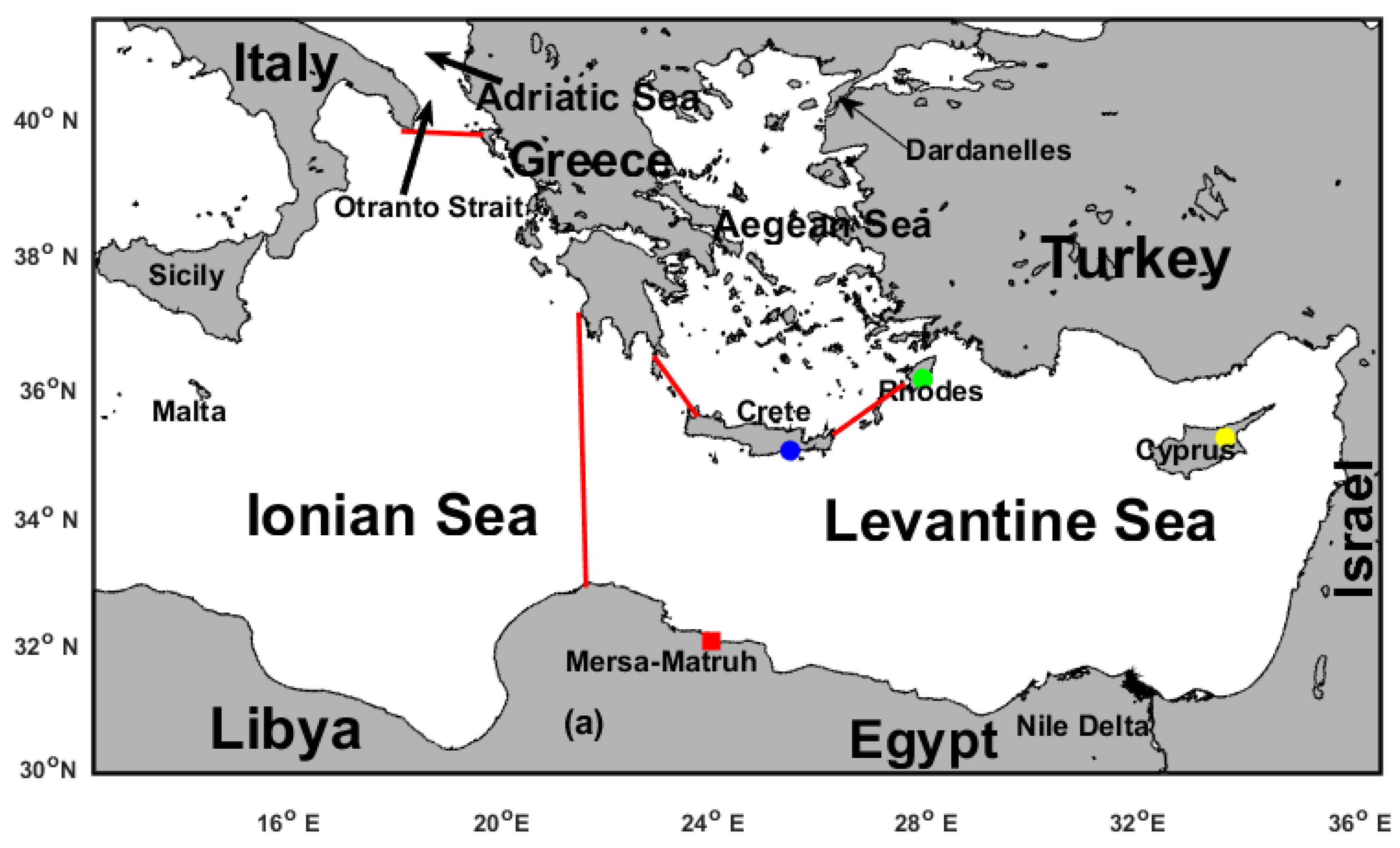
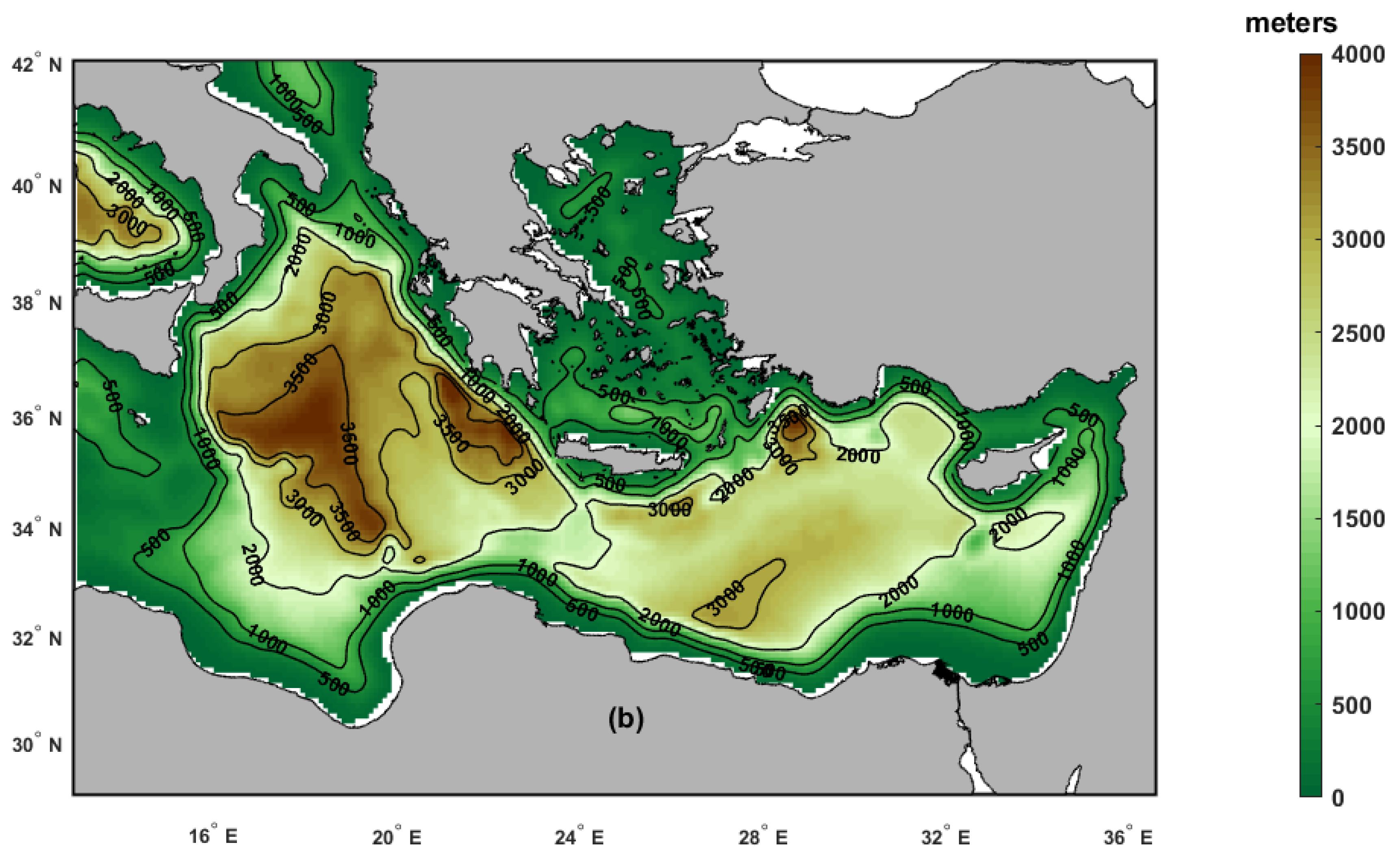
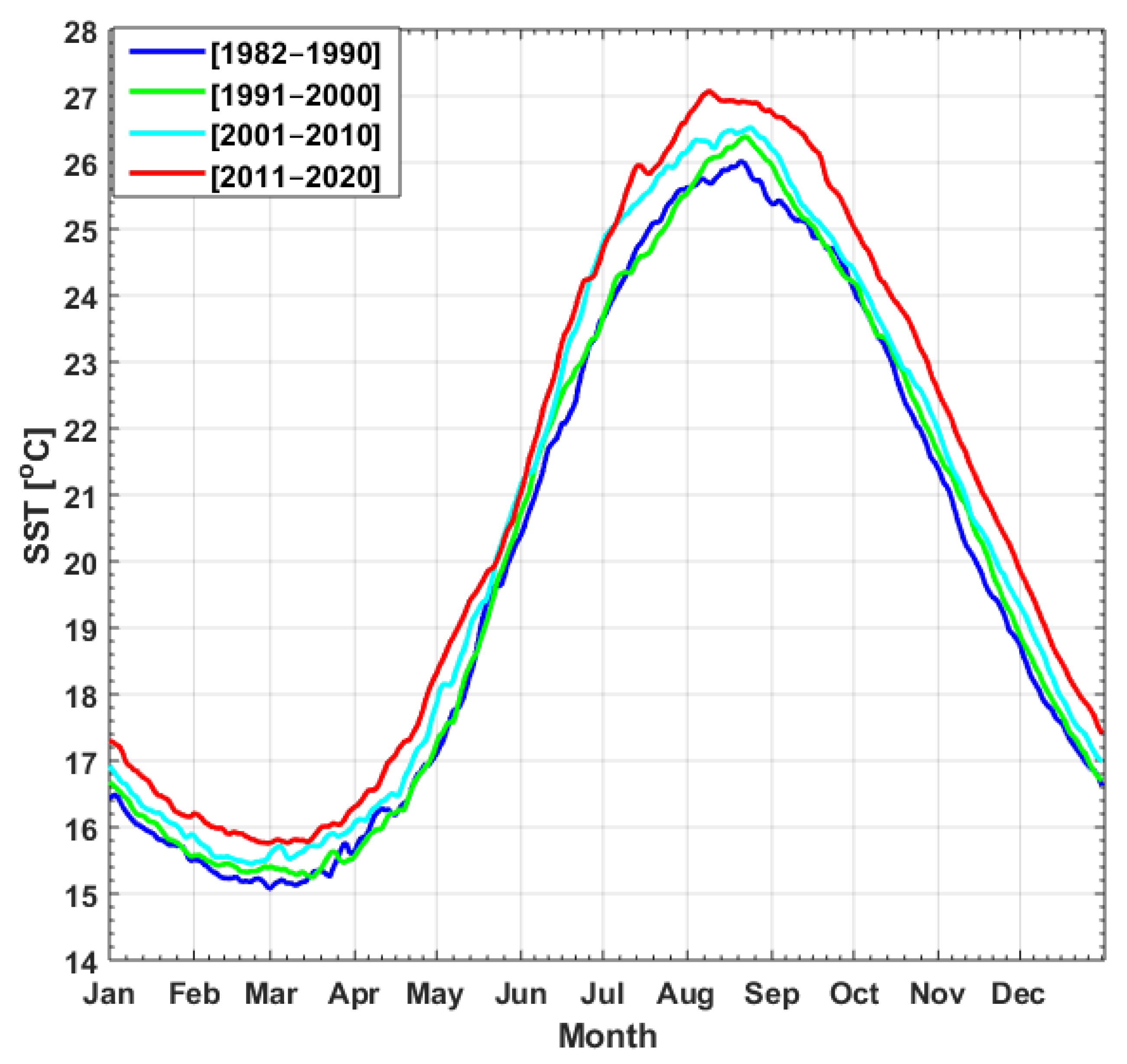
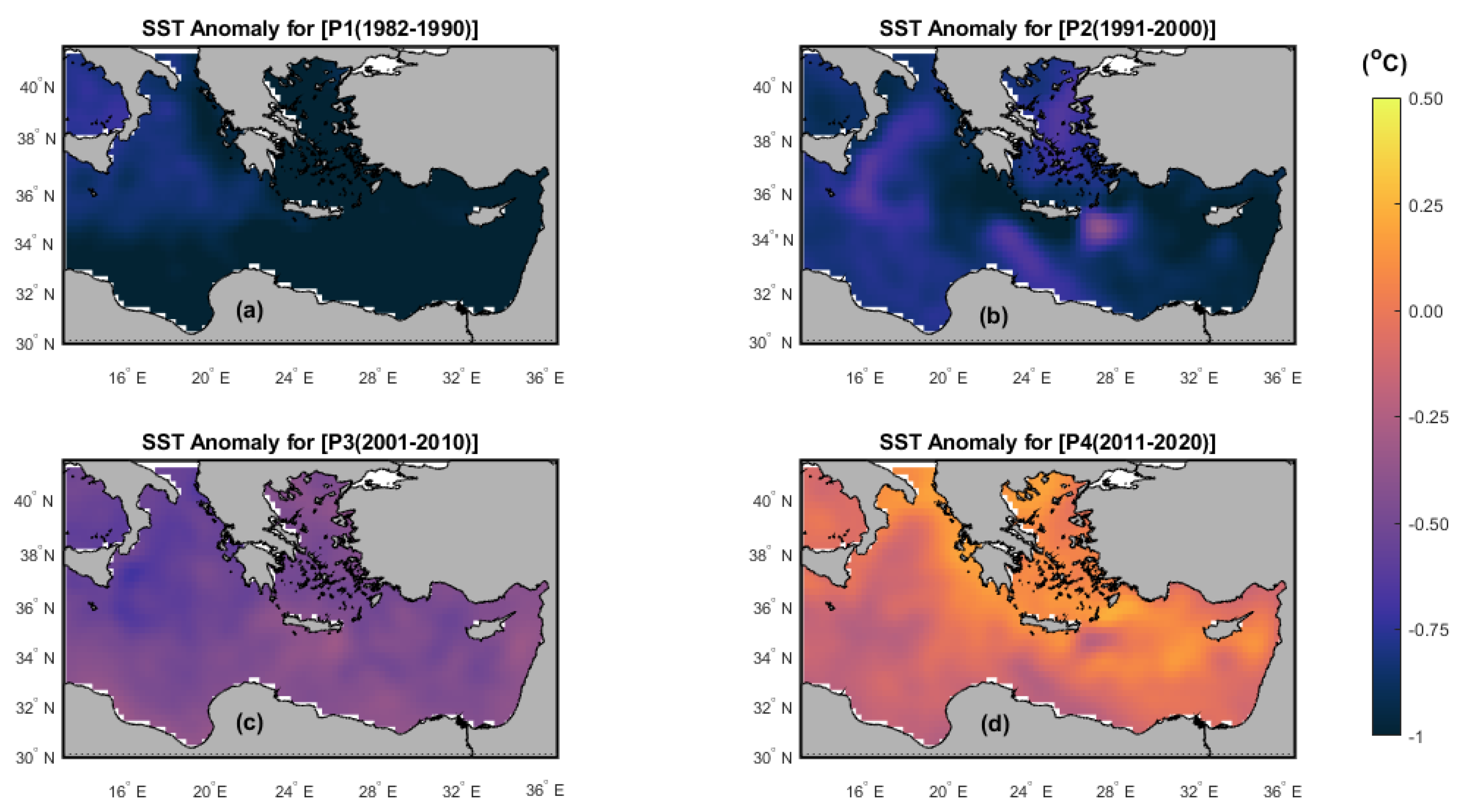
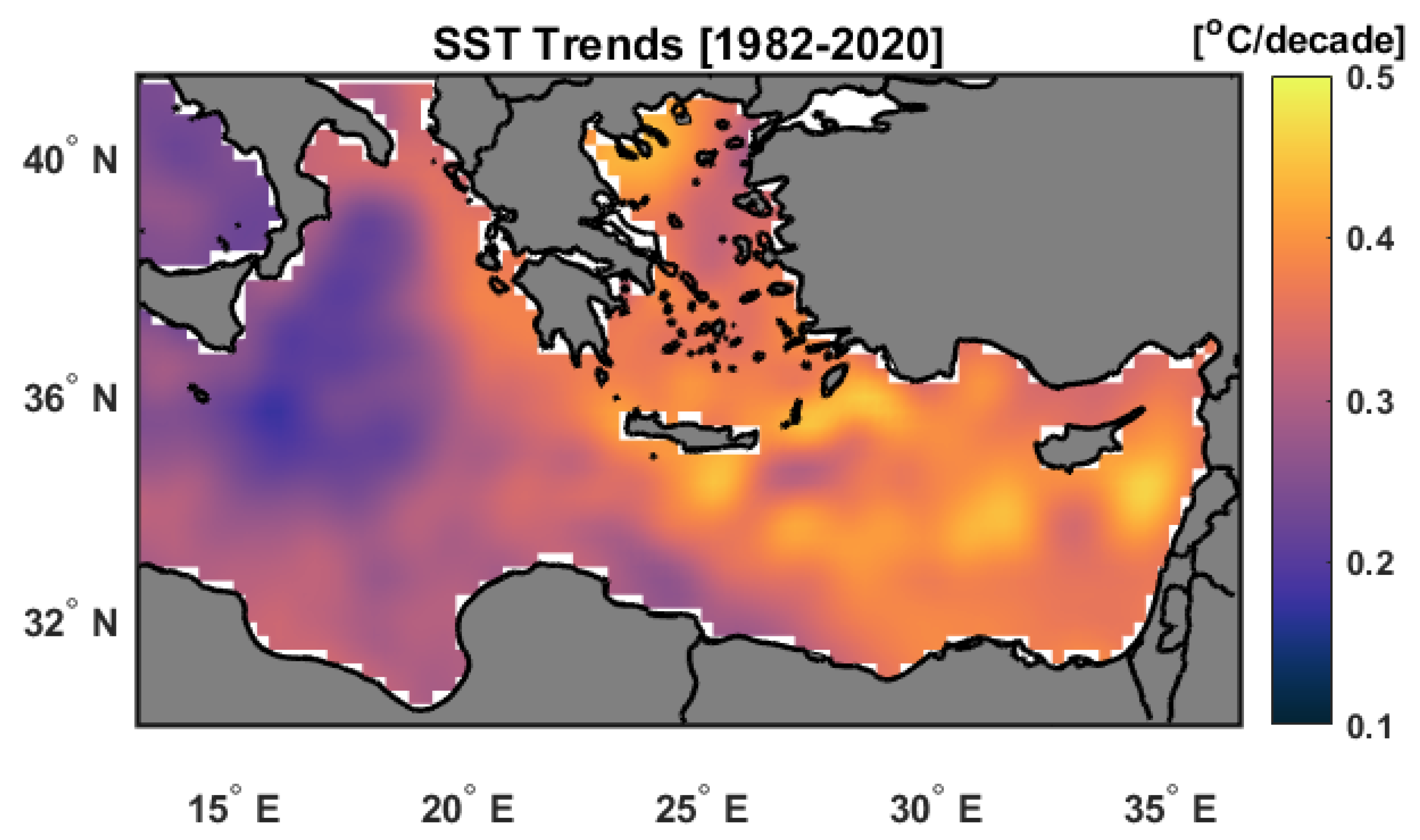


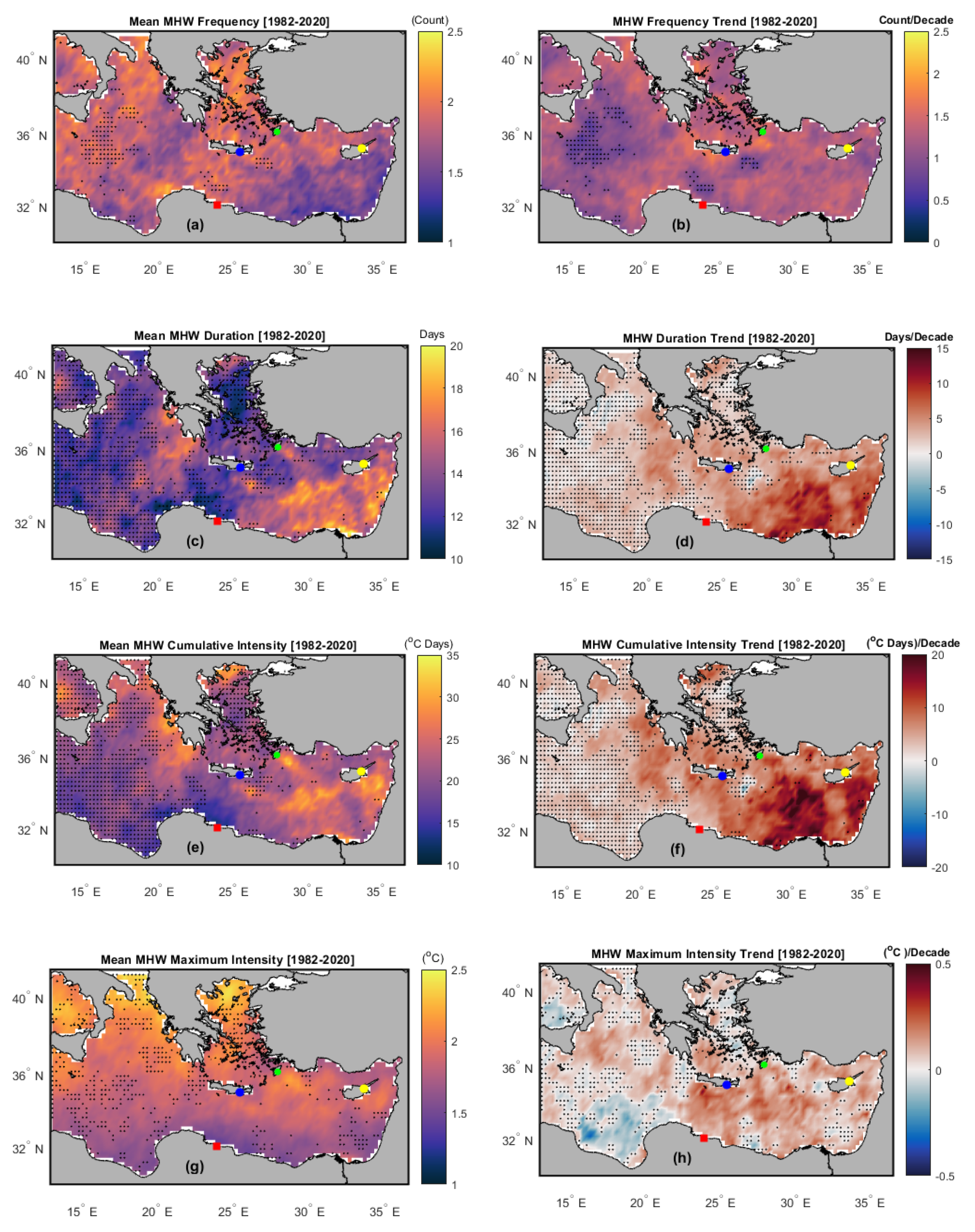
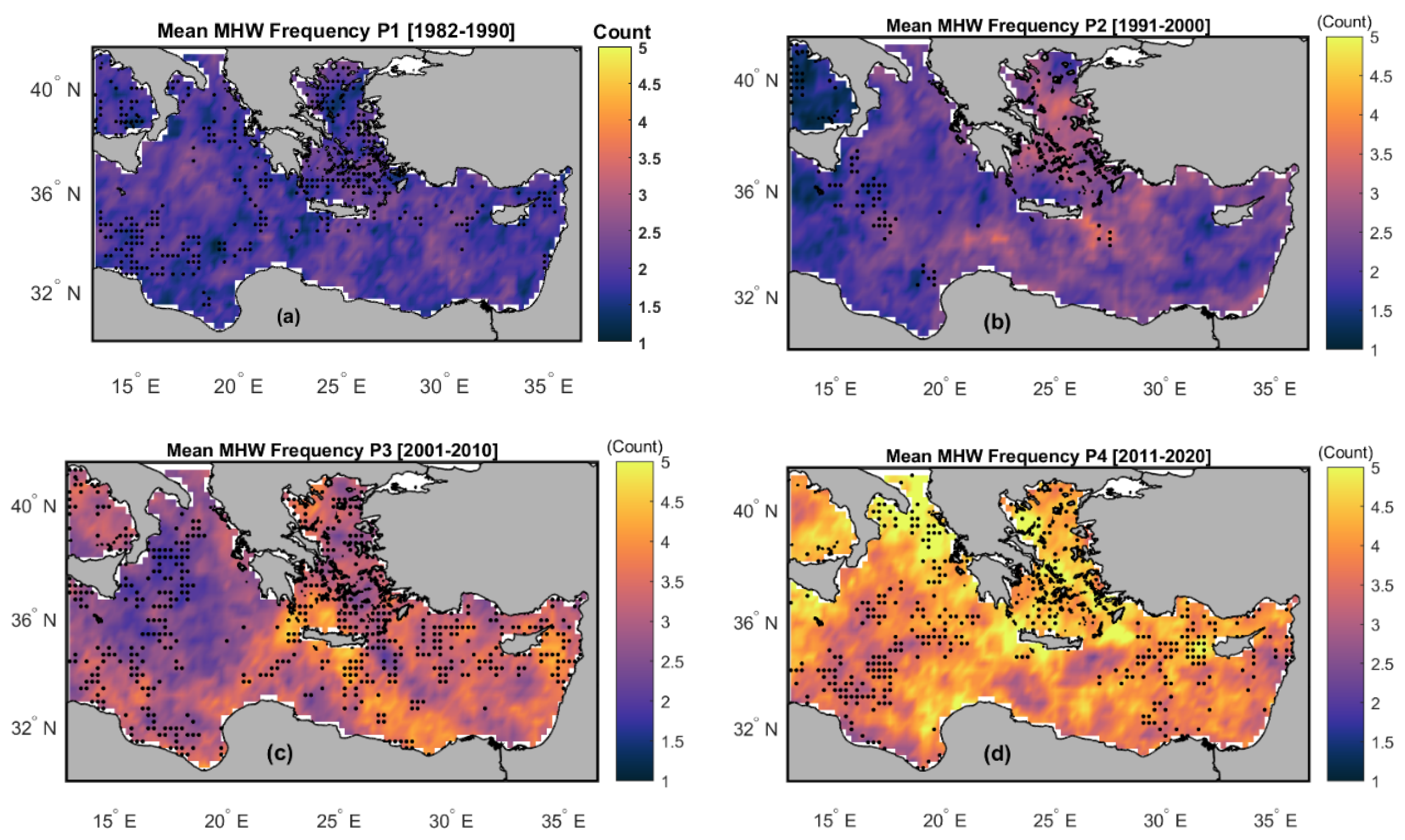
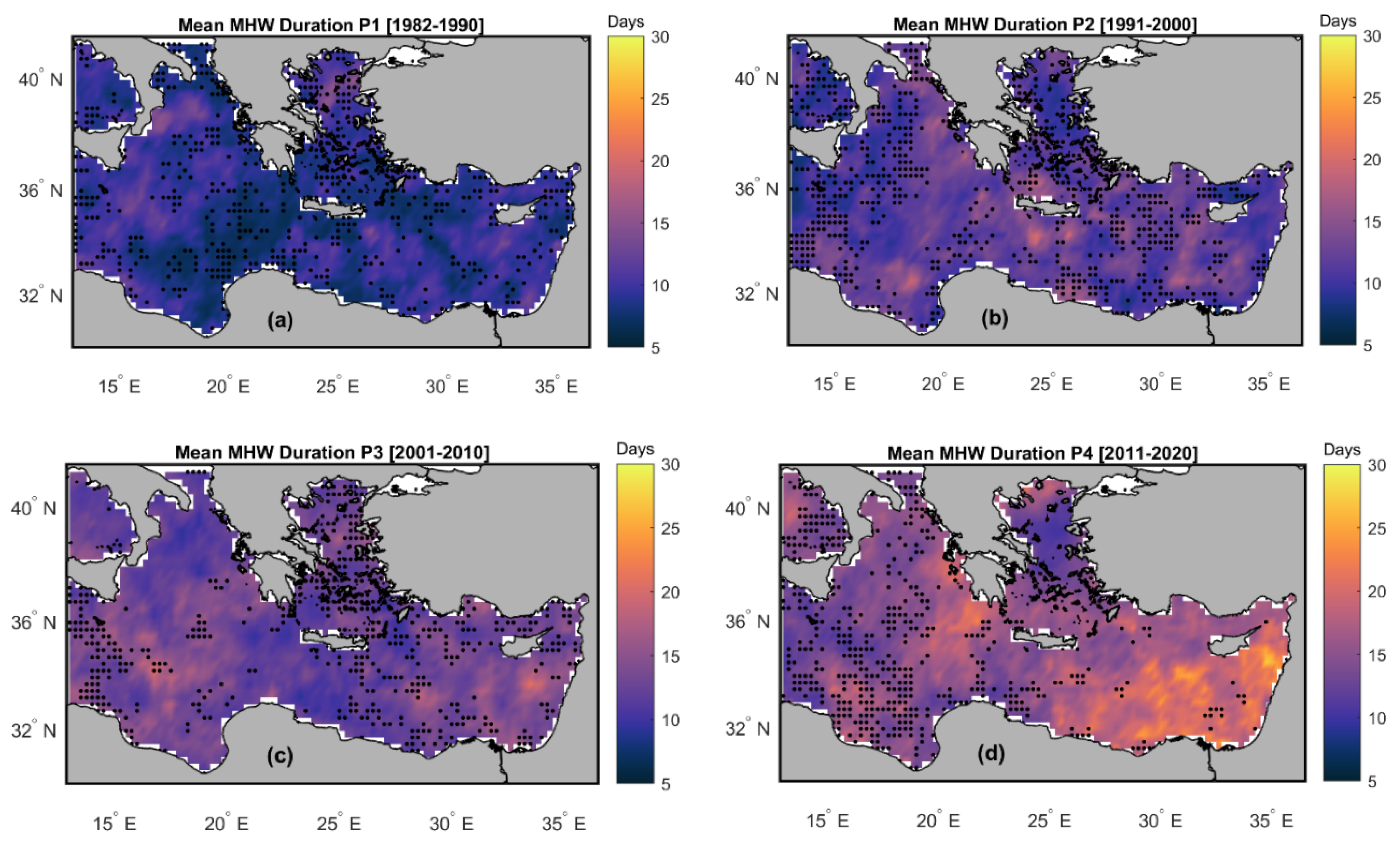


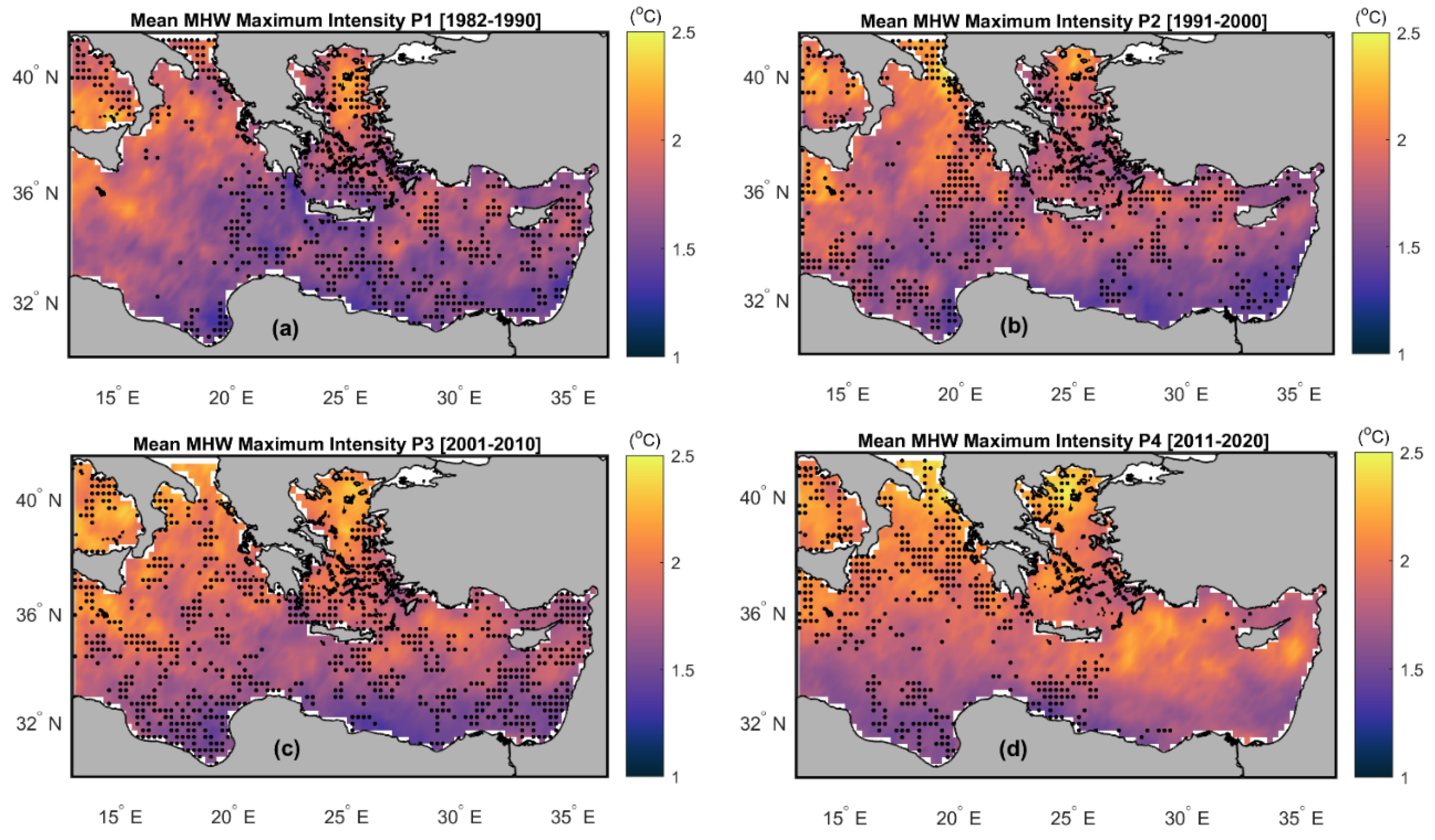
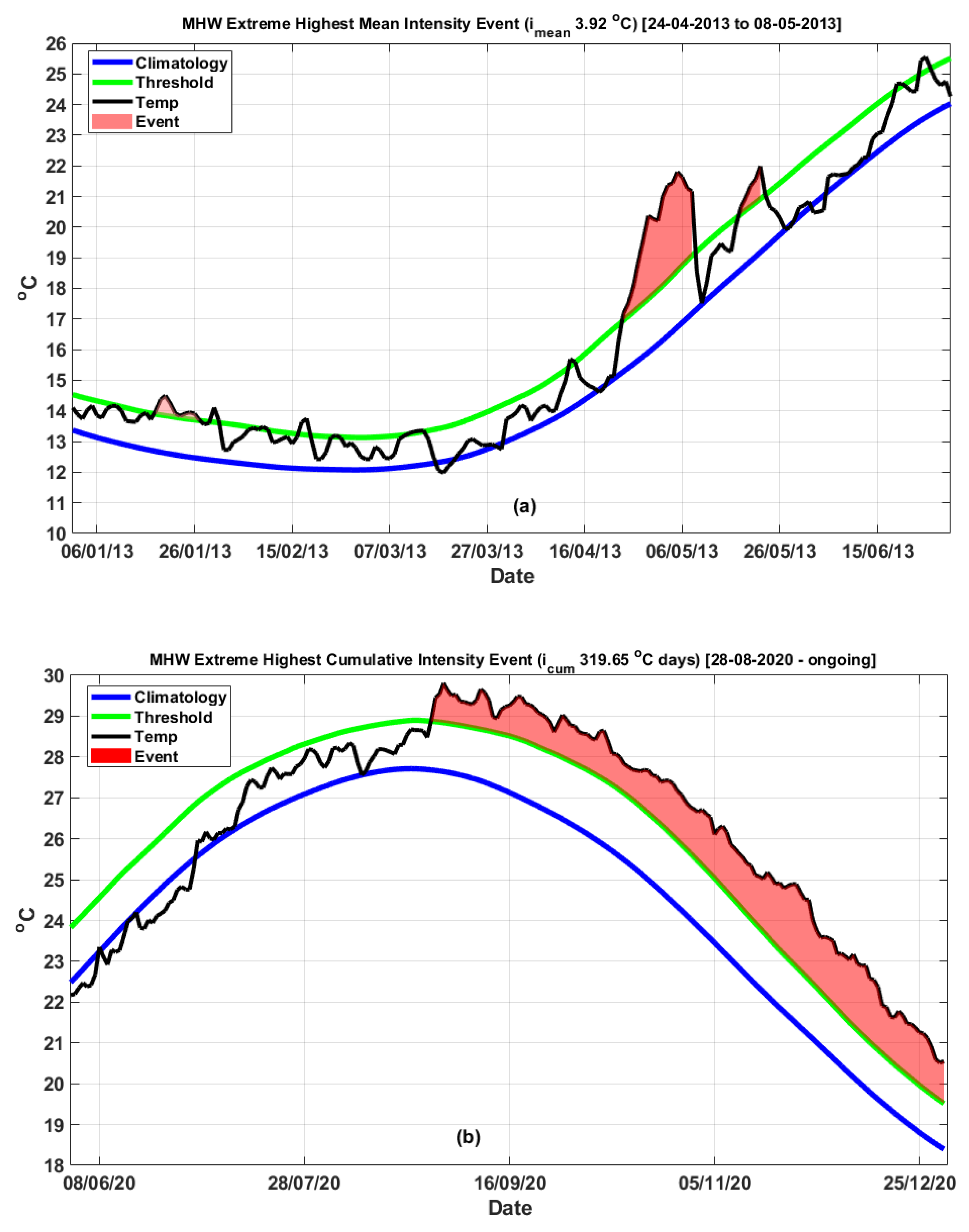

| Decade | Mean | Minimum | Maximum |
|---|---|---|---|
| P1 (1982–1990) | 19.98 | 15.07 | 26.01 |
| P2 (1991–2000) | 20.12 | 15.25 | 26.38 |
| P3 (2001–2010) | 20.48 | 15.44 | 26.52 |
| P4 (2011–2020) | 20.92 | 16.76 | 27.07 |
| MHWonset | MHWend | Long.°E | Lat.°N | Mean Duration (Days) | imax (°C) | imean (°C) | icum (°C Days) |
|---|---|---|---|---|---|---|---|
| 24-04-2013 | 08-05-2013 | 24.375 | 40.875 | 15 | 5.06 | 3.92 | 58.77 |
| 28-08-2020 | 31-12-2020 | 34.625 | 34.375 | 126 | 3.41 | 2.54 | 319.65 |
| 14-05-2020 | 20-05-2020 | 28.500 | 34.250 | 7 | 6.35 | 3.51 | 24.57 |
| Long.° E | Lat.° N | imax (°C) | imean (°C) | icum (°C Days) | Wind Stress Magnitude (N/m2) | 2m Air Temp. (°C) | Msl Pressure (mb) |
|---|---|---|---|---|---|---|---|
| 28.500 | 34.250 | 6.35 | 3.51 | 24.57 | 2.7 × 10−4 | 27.71 | 1015.2 |
| 24.625 | 35.875 | 5.66 | 3.25 | 22.78 | 6.2 × 10−5 | 27.69 | 1014.5 |
| 34.125 | 36.125 | 4.74 | 3.34 | 26.71 | 1.3 × 10−3 | 26.06 | 1014.1 |
Publisher’s Note: MDPI stays neutral with regard to jurisdictional claims in published maps and institutional affiliations. |
© 2021 by the authors. Licensee MDPI, Basel, Switzerland. This article is an open access article distributed under the terms and conditions of the Creative Commons Attribution (CC BY) license (https://creativecommons.org/licenses/by/4.0/).
Share and Cite
Ibrahim, O.; Mohamed, B.; Nagy, H. Spatial Variability and Trends of Marine Heat Waves in the Eastern Mediterranean Sea over 39 Years. J. Mar. Sci. Eng. 2021, 9, 643. https://doi.org/10.3390/jmse9060643
Ibrahim O, Mohamed B, Nagy H. Spatial Variability and Trends of Marine Heat Waves in the Eastern Mediterranean Sea over 39 Years. Journal of Marine Science and Engineering. 2021; 9(6):643. https://doi.org/10.3390/jmse9060643
Chicago/Turabian StyleIbrahim, Omneya, Bayoumy Mohamed, and Hazem Nagy. 2021. "Spatial Variability and Trends of Marine Heat Waves in the Eastern Mediterranean Sea over 39 Years" Journal of Marine Science and Engineering 9, no. 6: 643. https://doi.org/10.3390/jmse9060643
APA StyleIbrahim, O., Mohamed, B., & Nagy, H. (2021). Spatial Variability and Trends of Marine Heat Waves in the Eastern Mediterranean Sea over 39 Years. Journal of Marine Science and Engineering, 9(6), 643. https://doi.org/10.3390/jmse9060643







